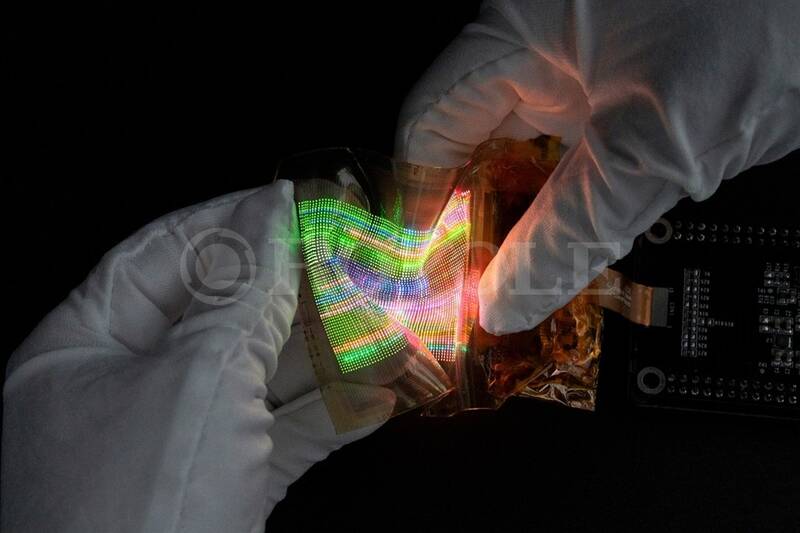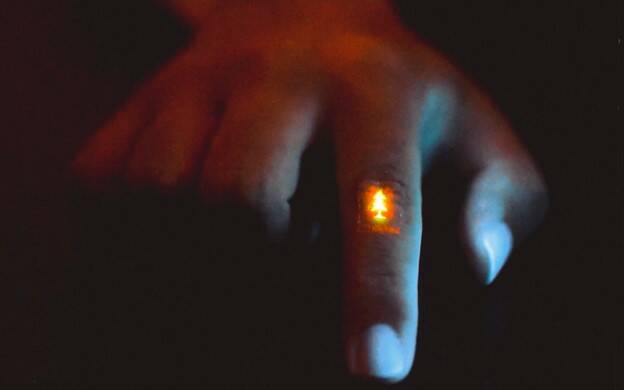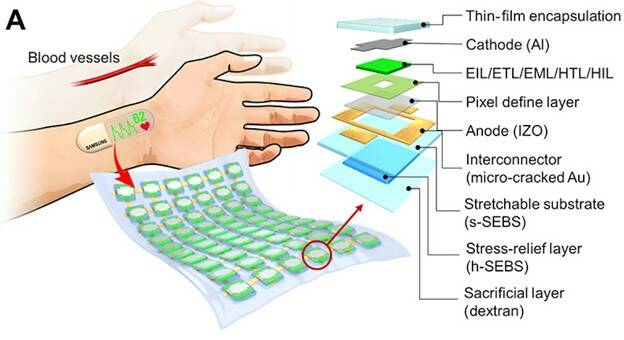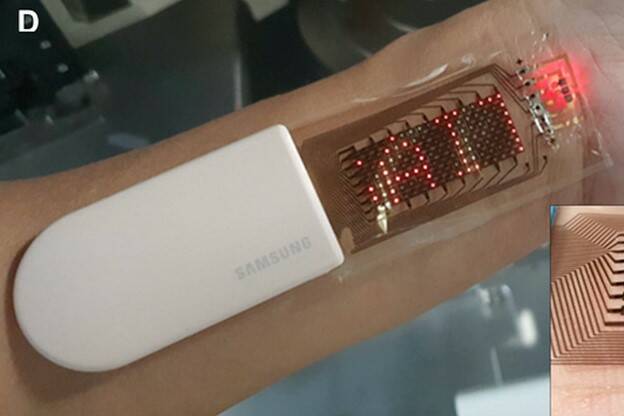The Next Display Technology Innovation: Stretchable Displays
In the last couple of years, we’ve gotten used to seeing curved display panels, new form factors, and a variety of flexible displays that can fold or roll, such as folding mobile phones and laptops. Now on the horizon are displays that are even more flexible: they can actually stretch into different shapes.
Last year, the world’s first stretchable microLED display was unveiled by Royole. The company reports it is capable of 130% stretchability, convex bending up to 40°, resolution up to 120 PPI, and transmittance up to 70%. The display is not only foldable and rollable, but also capable of 3D freeform shaping, including pulling, twisting, convex and concave deformations.

A 2.7" prototype microLED display from Royole with 96×60 resolution that is rollable, foldable, and stretchable. (Image © Royole)
More recently, Samsung has teased the concept of a display that can be stretched in all directions like a rubber band. While still mostly in the prototype stage, there are some exciting developments in this arena that could bring stretchable displays to market in the not-too-distant future.
How To Make a Display Stretch: Multiple Approaches
Stretchable displays have been the focus of research, with several different approaches being explored, including:
- The Korea Institute of Machinery and Materials (KIMM) research team in February announced the successful development of a 3-inch microLED display that stretches up to 25% without distorting the image. Based on metamaterials—man-made materials with unique mechanical properties that don’t exist in nature.
- Meanwhile, a research team at Stanford University recently announced the development of “a method to produce a high-brightness elastic light-emitting polymer, which functions like a filament in a lightbulb. The group’s resulting display is made entirely of stretchy polymers – synthetic plastic materials. The device has a maximum brightness at least two times that of a cellphone and can be stretched up to twice its original length without tearing.”1

The Stanford University logo (a tree) can be seen on the flexible light-emitting film worn by researcher Zhitao Zhang. The film can hold up to flexing and wrinkling, as her on the knuckle. (Image credit: Zhitao Zhang and Jiancheng Lai of Bao Group Research Lab)
The challenge addressed by the Stanford team is that materials with good light-emitting properties tend to be rigid and brittle, while stretchy materials such as rubber tend to have poor light transmission. The breakthrough came when researcher Zhitao Zhang discovered that Super-Yellow, a yellow-colored light-emitting polymer, became soft and pliable when mixed with a type of polyurethane, a stretchy plastic. And not only did it retain its light-emitting capability, but it even emitted a brighter light.
The research at KIMM and Stanford are just a few of the many stretchable-display development initiatives currently underway:
- Another approach under consideration for making stretchable displays is to use reflective display technology. Unlike emissive (e.g., OLED) and transmissive (e.g., LCD) displays, reflective displays don’t require any power to operate. They are highly readable under ambient light and maintain color consistency even when stretched.2
- A different development pathway is being pursued by a research team at Korea’s Gwangju Institute of Science and Technology (GIST). They have connected individual miniLEDs together with stretchable interconnects in a double-layer modular design. This method produces a high-fill factor, inorganic LED display with stretch capabilities.3
- Taking yet another approach is Finnish company Canatu that produces materials based on carbon nanotubes (CNT). For example, their CNT membrane is billed as the world’s thinnest and strongest free-standing CNT membrane. It has demonstrated high transmittance, touch sensitivity, heat resistance, and high contrast, opening the door to a wide array of potential display and other applications.
Stretchable Displays: A Second Skin
Imagine carrying around a miniature display device that you can stretch into a large screen and stick to any flat, curved, or irregular surface when you want to use it.4 Or a mobile display device that you could simply crumple up and shove in a pocket. While it may be fun to imagine future stretchable applications, many of the most compelling use cases are focused on saving lives and improving health.
For example, researchers have long envisioned having wearable display patches that will flex and stretch naturally as a patient moves, like a second layer of skin. Patches are under development that incorporate both sensors and displays for real-time patient monitoring.
For example, the Samsung Advanced Institute of Technology (SAIT) has been able to “integrate a stretchable organic LED (OLED) display and a photoplethysmography (PPG) sensor in a single device to measure and display the user’s heart rate in real-time, thus creating the ‘stretchable electronic skin’ form factor.”5 One benefit of this approach is that it relies on existing semiconductor fabrication processes, bringing the prospect of stretchable display commercialization tantalizingly close.


Schematic (top) and prototype (bottom) of Samsung’s stretchable heart monitor display. (Images © Samsung/SAIT)
So far, the various stretchable displays under development offer only low-resolution, basic image capabilities—you won’t be watching video content on one anytime soon. But as scientific and industrial research teams continue to push forward, we can look forward to seeing these and other technological wonders, which were once only imagined by the likes of science fiction writers and futurists.
CITATIONS
- Mackenzie Prillaman, “Stanford engineers develop a stretchable display that could revolutionize how humans interact with electronics.” Stanford News, March 23, 2022.
- Kim, D.Y., Kim, MJ., Sung, G., et al. “Stretchable and reflective displays: materials, technologies and strategies.” Nano Convergence 6(21), 2019. DOI: 10.1186/s40580-019-0190-5.
- Namyun Kim, Juho Kim, Jimin Seo, Changeui Hong, and Jongho Lee, “Stretchable Inorganic LED Displays with Double-Layer Modular Design for High Fill Factor.” ACS Applied Materials & Interfaces 14 (3), pages 4344-4351, 2022. DOI: 10.1021/acsami.1c23160
- Yongtaek Hong, Byeongmoon Lee, Eunho Oh, and Junghwan Byun, “Stretchable Displays: From Concept Toward Reality.” Information Display, April 2017, pages 6-11.
- Gae Hwang Lee, Hyunbum Kang, et al., “Stretchable PPG sensor with light polarization for physical activity–permissible monitoring.” Science Advances, 8(15), 2022. DOI: 10.1126/sciadv.abm3622
Join Mailing List
Stay up to date on our latest products, blog content, and events.
Join our Mailing List
